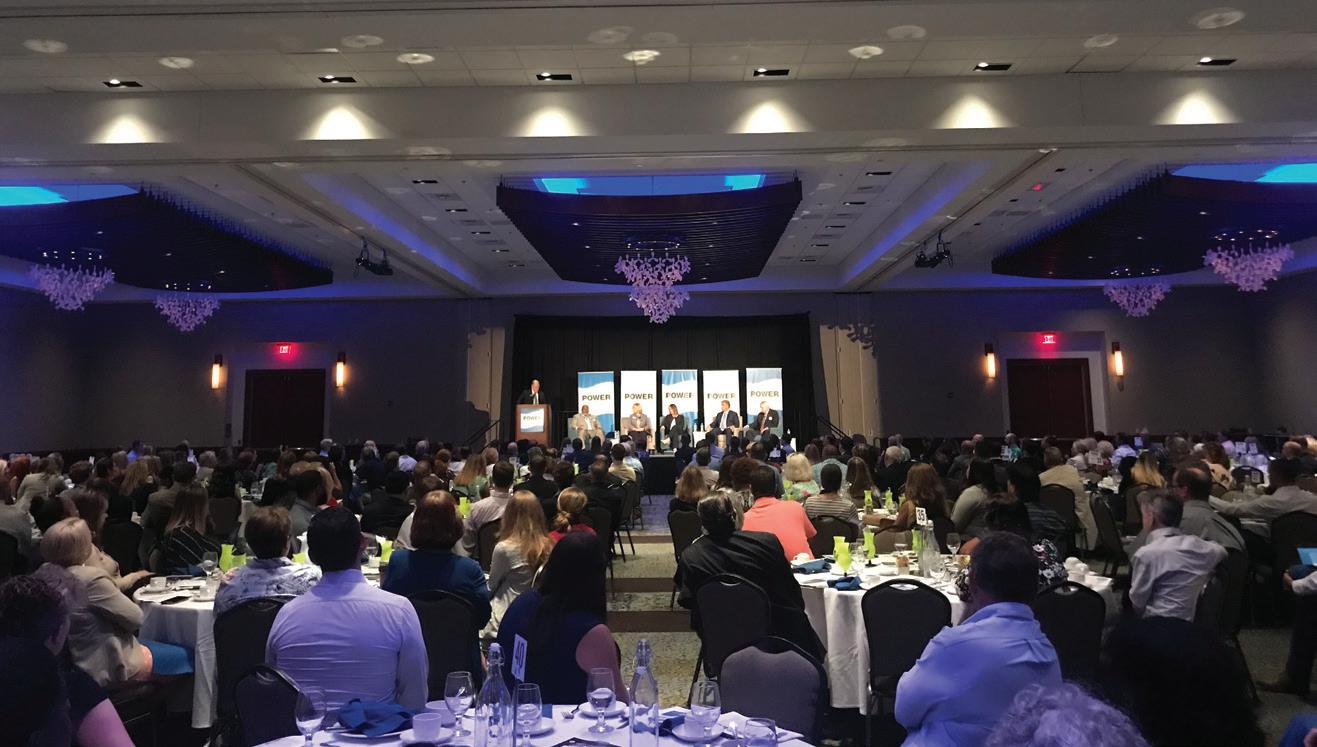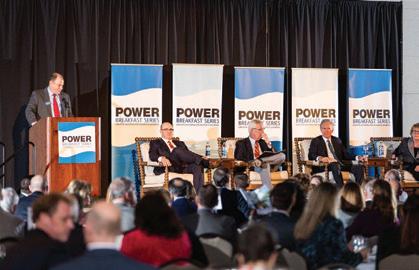
6 minute read
COVER STORY: WILMINGTON GOTHIC
WILMINGTON GOTHIC
BY NEIL COTIAUX | ILLUSTRATION BY MARK WEBER
NEWCOMERS ARE MAKING WAVES IN AREA REAL ESTATE, FUELED BY THE ABILITY TO WORK FROM HOME
One year ago, just before the state imposed its first coronavirusrelated lockdown, Madeline McCarthy and her husband, Robert Elkins, were getting comfortable in the log cabin they had bought in Saluda. Their move to the picturesque community outside Asheville followed more than a year roaming North America in an RV and before that, two years living near a beach and rainforest in Costa Rica.
All the while, McCarthy worked remotely as a mortgage underwriter for a Northern Virginia lender.
“All I need is internet. I had set up a small office in my RV with a desk and my monitors,” McCarthy said. Now, during the pandemic, all 150 or so employees of the Tysons Corner firm that employs her work remotely.
The couple moved into a second home on South Ninth Street in Wilmington two months ago, drawn to the region by former neighbors in the D.C. area.
“They’re either retiring or able to work remotely in the last maybe five to 10 years of their careers, and they’re working here and loving it,” McCarthy said.
“There were multiple offers on this house, so we did pay more for it than the list price,” she said of the renovated 118-year-old property, an easy walk to downtown’s central business district.
McCarthy’s ability to work remotely represents one of several factors that continue to propel home sales in the tri-county area (Brunswick, New Hanover and Pender counties) to record levels.
According to December 2020 data from the National Association of Realtors, 21% of employees nationally are now working from home 100% of the time. That number is forecast to drop to 18% this year and to 12% in 2022 as the pandemic ebbs and workers divide their time between home and the company office.
Allison Donovan, a broker at Nest Realty, said the retreat to home offices as the state’s first lockdown began was a factor in keeping last year’s housing market healthy.
“I was getting a lot of requests for four bedrooms, two baths because people need the office space; they’re requesting the fourth bedroom or an additional room to have a home office,” she said. “They also want to make sure that the WiFi in the area’s good and in the house it has the right connections.”
Wi-Fi also helped close sales when buyers searched from afar.
“I’ve had several clients that can work remotely and have chosen Wilmington. One recently moved from California … I sold them a place in Carolina Beach last year. But we did the house hunt remotely. I FaceTimed them at several houses,”
Madeline McCarthy and her husband, Robert Elkins, bought a second home in Wilmington, where she can work for her Virginia firm from her home office.
Donovan said.
Single-family homes sold across the tri-county area in 2020 totaled 11,155, up 22% over 2019 and shy of the prior peak of 12,055 in 2006. Nearrecord sales resulted from strong demand, low interest rates, rising rents that spurred home buying and the attractiveness of living along the coast, said Anne Gardner, CEO of Cape Fear Realtors, a regional trade group.
For the month of December, closed sales increased 33% year-overyear, and the median sale price for single-family and townhomes/condos combined rose 19% to a new high of $246,000.
In Brunswick County, the residential market in 2020 set a fullyear record with total sales topping $2 billion, a 51% increase over 2019. The number of units sold increased by 28.8% to 6,331, and the average sale price reached $340,741.
“Construction, moving, mortgages, personal spending at retail – virtually every real estate sale impacts the local economy for the better long term,” observed Cynthia Walsh, CEO of the Brunswick County Association of Realtors. “Taking a look at the retail moving into Shallotte and Leland, I think the economic firepower is here and growing.”
While the multiplier effect of housing-related expenditures (furniture, appliances, etc.) accounted for 16% of the total economic impact of a typical home sale in North Carolina in 2019, according to NAR – the last year for which data were available – new home construction accounted for 50.5% of the total impact.
But with a low inventory of new housing stock in the Cape Fear region bumping up against attractive rates, strong demand and competing offers, prices may continue to climb and usher in a cooling-off period in sales, and in turn diminish the positive community impact of home buying.
Gardner cites labor and material shortages in construction and a scarcity of developable land as “pressure points” that could eventually lead to a market slowdown if left unaddressed. At year’s end, only 1.5 months’ supply of housing was available across the three counties, she said, compared to 3.6 months in December 2019, a drop of 57%. More properties will come on the market as the peak selling season begins, Gardner believes.
Pender County, where developable land exists, is likely to see sustained home construction.
With its recent closing on 130 acres along Sidbury Road at the PenderNew Hanover line and more than 1,000 other acres under contract, McAdams Homes, for one, expects to build up to 5,000 for-sale and for-rent units in southern Pender County over the next 10 years. This year, the firm intends to break ground for 315 single-family and townhome lots.
But as developers eye additional land in more rural sections of Pender County, internet connectivity remains an issue.
“I would say 75% of Pender County’s land area is unserved and 25% is served,” said Jody Heustess, vice president of marketing and customer care at ATMC, which developed its first fiber-optic community in Brunswick County 16 years ago. “And once we did that we had other developers come in and say ‘I want that for my community’ and ‘Where can I get this?’” he recalled.
This summer, ATMC will break ground on a $28.9 million project to bring high-speed internet to more than 6,800 residential addresses in Pender County using 460 miles of buried Corning fiber. The project is funded in part with a $21.6 million grant from the U.S. Department of Agriculture’s ReConnect broadband program.
While ATMC was given 60 months to complete the project, Heustess said the firm hopes to get it done in 24.
Meanwhile, mortgage rates continue to support the market. Inching up from last year, the rate on a 30-year mortgage averaged 3.05% at mid-February, according to Bankrate. NAR expects that rate to reach 3.25% in 2022.
“The rates are still super low, and more people have realized they can work at home now,” said Nest Realty’s Donovan.
Now out of an RV and into their latest home, Madeline McCarthy and her husband are frequenting breweries and restaurants downtown and shopping for furnishings.
“I’m looking forward to warm weather so I can get out and explore our new neighborhood a little bit more,” McCarthy said. “But so far, we found people to be very welcoming and very friendly.”

SERVED BY




The Power Breakfast Series is a quarterly gathering of the business community and other community leaders to talk about issues of interest to our region. Each breakfast features a panel discussion or individual speaker focusing on topics of interest to local companies. The breakfasts provide a unique networking opportunity since they are attended by a range of influential people including busines owners, executives, community leaders and many others.
Want to plug into the Power? Become a Power Breakfast sponsor! Sponsors are recognized before and during each event and have a table up front. Learn about sponsorship options by contacting Maggi Apel at mapel@wilmingtonbiz.com. Note: Power Breakfasts continue bringing important topics to the community through Covid by following the gathering restrictions and broadcasting the events online.









